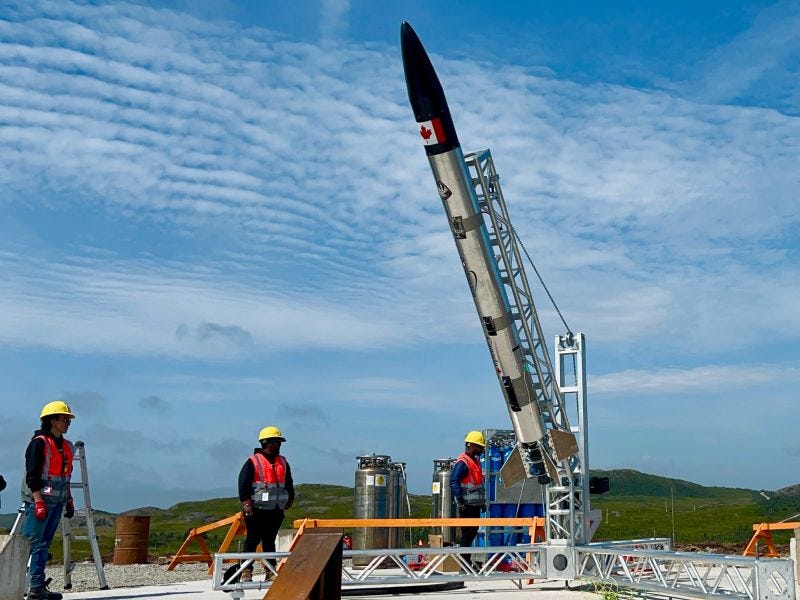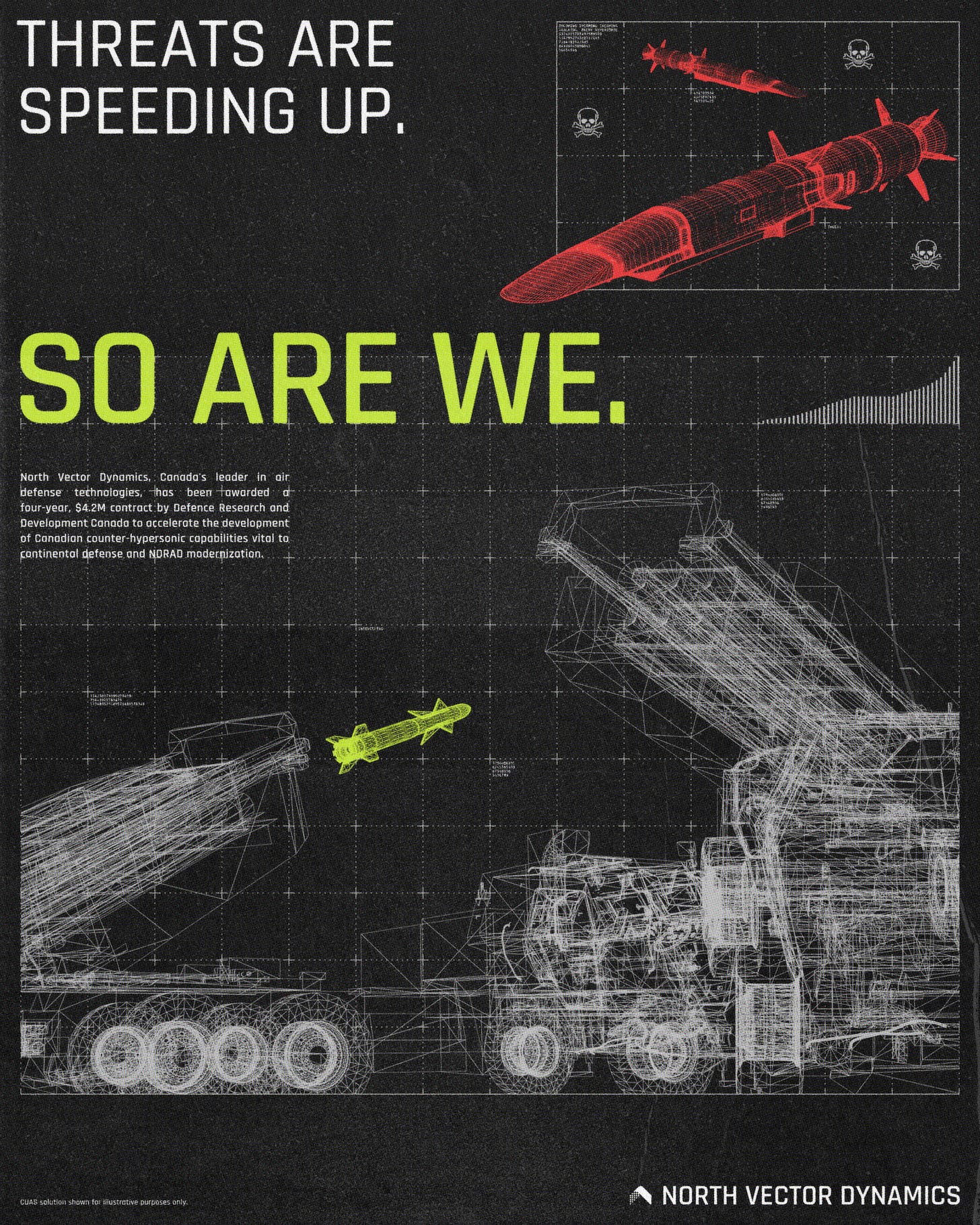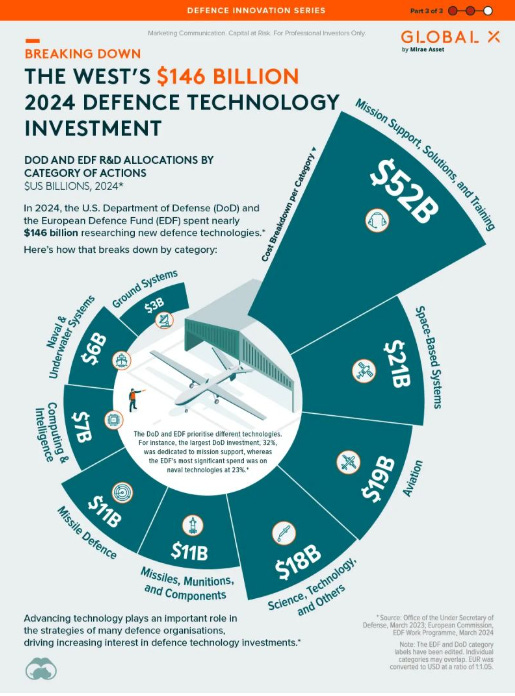Canada’s 428-Firm Arsenal
Red-tape has dual-use innovators eyeing the exits
🎯 Three-Shot Burst
Earlier this summer, in partnership with the Council of Canadian Innovators, we launched an initiative to map Canada’s dual-use tech ecosystem. We know our innovators are building world-class technologies. But too often, they fly under the government’s radar — we are often told that Canadian companies don’t have the necessary capacity to meet Canada’s defence needs. This is especially concerning as Canada sets out to quadruple defence spending by 2030. So we set out to find the truth…
Reality check: Almost 500 Canadian companies developing dual-use technologies with both defence and non-defence applications responded. The Globe & Mail has published our top line results.
Oh Canada: Hundreds of Canadian firms have the talent, scalability and product maturity to contribute directly to national security in cutting-edge spaces where Canada can be a net contributor to NATO. Many are already selling to other NATO allies. But bureaucratic processes are holding them back from participating in Ottawa’s defence spending push.
While almost 90 per cent of companies said procurement was important to their success, about half of them said access to customers, which includes government procurement, was their biggest obstacle to scaling.
Nearly 30 per cent of respondents, or approximately 123 companies, said they’ve seriously considered leaving Canada in the past year and roughly the same percentage said they make more than three-quarters of their revenue exporting.
Bottom line: We need to open the door – now – to home-grown innovators building at startup speed before their technologies are snapped up by foreign buyers or venture offshore for friendlier markets.
[Editor’s note: Thanks to the entrepreneurs that took the survey. We are actively briefing federal officials on the detailed results to inform the forthcoming defence industrial strategy.]
Related:
The economic promise – and peril – of higher Canadian defence spending
Beating Ploughshares into Swords: A Defence Industrial Strategy for Canada
Canadian officials are in Europe this week, courting Arctic allies to counter Russia, promising additional support for Ukraine while talking about eventual peace and considering boots-on-the-ground once the war ends; visiting a Swedish firm competing with the US maker of the F-35, and inaugurating the construction of Canadian icebreakers in Finland
According to Politico: Minister Joly provided hints on the forthcoming defence industrial strategy, telling reporters on the trip that BDC will support companies that want to invest in defence, the National Research Council Canada will focus on dual-use, civilian and military research, and the Canadian Space Agency’s mandate will be broadened to include defence as well
📋 Procurement Update
The White House released text of its new trade framework agreement with the EU, which includes a curious Section 7 on defence:
“The European Union plans to substantially increase procurement of military and defence equipment from the United States, with the support and facilitation of the U.S. government. This commitment reflects a shared strategic priority to deepen transatlantic defence industrial cooperation, strengthen NATO interoperability, and ensure that European allies are equipped with the most advanced and reliable defence technologies available.”
Bottom line: Could the eventual Canada/US deal include something like this as well? And if so, does this undermine Canada’s participation in the ReArm Europe plan? I.E.: Canada agreed to buy more from Europe, and Europe in turn commits to buy more from America
Changing the rules: Changes to rules for ‘national security’ contracts bypass competition and raise concerns of potential abuse, say procurement watchers
“If the government wants to spend a lot of money quickly and to spend it in a more directed fashion to bolster Canadian sovereignty, then we might have recourse to that instrument. I think it is an important one in our toolbox, and giving the cabinet more ability to make these types of decisions is important.” — Philippe Lagassé
Running out of runway: As the Trump administration grows irritated, Canada weighs the potential blowback of not proceeding with F-35 order… Pentagon’s tech innovation head, a critical link to Silicon Valley, abruptly steps down
Rare earths: A 2-year-old startup manufacturing rare earth magnets in North Carolina, has quietly landed more than $10 million in Defense Department contracts across every branch of the U.S. military. Vulcan Elements wins Pentagon deals as $65M round fuels expansion
Where did the money go?: Are US taxpayers inadvertently funding China’s innovation?… Reliance on IT contractors exposes Canada to risk of foreign interference
Requirement process: The Pentagon announced major procurement reforms that now frame requirements as operational problems, not technical specs
Head start?: The Canadian Patrol Submarine Project (CPSP) is Canada's largest up-and-coming defence acquisition program. The five contenders are: Hanwha, Naval Group, SAAB, TKMS, and Navantia. Spanish firm Navantia is launching supplier engagement sessions across the country
💾 Canada’s first Defence Tech Hackathon
September 20 in Toronto at the DMZ
The Defence Tech Hackathon is a catalyst to jumpstart a world-class ecosystem that builds sovereign capability in Canada. Our goal is to attract top talent, rapidly prototype real-world solutions, and bridge the gap between innovators and military end-users.
UPDATE: As of August 17, the sign up form is closed. We are finalizing logistics and will be in touch with participants.
💾 Deal Corner
Prandtl Dynamics provides low-collateral counter-UAS solutions.
Their ultrasonic “soft-kill”, energy-based devices project narrow-band ultrasound to scramble onboard cameras and IMUs, neutralizing drones without RF emissions, shrapnel, or collateral damage, making them uniquely safe, compliant, and legal to use in civilian and defence contexts. This differentiates them from kinetic or RF jamming solutions, which often face regulatory restrictions.
The company placed 2nd at Canada’s 2024 CUAS Sandbox, outperforming major incumbents and earning $375k CAD in prize funding. Products include CRATOS (fixed-mount area denial) and CALLIOPE (portable rifle-mounted), designed as drop-in effectors for existing CUAS stacks. Upcoming evaluations include RCMP (Canada), Sugar Land Airport (Texas), and the British Transport Police.
Pre-seed backed by Jason Calacanis and now raising a US$2.5M seed to scale manufacturing and fulfill preorders starting Q4 2025.
Reply to this email to be put in touch with CEO Parth Mahendru.
🤝 Sovereign Capability
Launch window
Tomorrow, NordSpace will attempt Canada’s first fully commercial rocket launch when the Taiga’s (pictured below) launch window opens at the Atlantic Spaceport Complex in Newfoundland.
The window is primarily dependent on weather, with winds from Hurricane Erin factoring into safety calculations.
Good luck to CEO Rahul Goel the NordSpace team!
Related:
Federal government taps Cohere to work on use of AI in public service
Stealthy semiconductor manufacturer Ranovus plans $100 million expansion of Ottawa facility… the company doesn’t do publicity or marketing, according to its founder… General Fusion staves off funding crunch with $30 million CAD to fuel quest for commercial fusion power… Canadian-led Aalo Atomics raises $100-million USD Series B for its nuclear power plans
Federal challenge grants Photonic and Xanadu funding to advance quantum defence tech projects… How will quantum technologies reshape the defence industry?
What is the price of Canadian sovereignty?… In its heyday, Atomic Energy of Canada Limited was a crown-owned Canadian nuclear innovator that designed & simultaneously delivered 11 near-turnkey Canadian designed CANDU reactors abroad, often with technology transfer to 7 countries, built over 20 domestic units, & maintained world-class R&D labs
A Canadian drone entrepreneur believes Canada is now firmly at the back of the bus from a procurement and supply chain development perspective. Other countries have been in the queue for payloads, radios, and chips starting three years ago while the bulk of Canada's procurement isn't expected to go to RFP until 2027
‘Build, baby, build’ must include Canada’s key digital infrastructure — not just roads, ports and pipelines
Canadian defence firm Roshel to make ballistic steel through Swedish partnership… New Canadian stainless steel tariff could lead to massive price increase on infrastructure projects
The NATO Association of Canada releases the Canadian Arctic Foreign Policy Proposal for 2030… Brutal Arctic conditions are testing U.S. and allied forces
⚔️ Combat Readiness
North Vector Dynamics secures $4.2-million contract with National Defence for hypersonic propulsion
Calgary-based defence tech startup that recently emerged from stealth has been awarded a four-year, $4.2-million contract by Canada’s defence department as the federal government looks to increase military spending.
North Vector Dynamics, co-founded by University of Calgary engineering professors, calls itself a defence and autonomy company that develops high-speed aircraft propulsion, training systems for drone attacks, and missile systems guided by artificial intelligence.
Defence Research and Development Canada awarded the contract to obtain “expert engineering support” for “high-speed and hypersonic aeropropulsion technologies.” This covers aircraft flying at speeds above Mach 5, or five times the speed of sound.
Related:
$146 billion: That is how much the U.S. DoD and the European Defence Fund invested in defence technology R&D in 2024. The biggest chunks went to:
$52B → Mission support, solutions & training
$21B → Space-based systems
$19B → Aviation
$18B → Science & technology
China’s commercial space sector has proliferated over the last decade thanks to political prioritisation and extensive venture capital funding
The venture capital arm of United Airlines is investing in Astro Mechanica, a startup specializing in high-speed flight
Canada’s Richard Warnica on NASA grappling with major proposed budget cuts
🍁 Canada’s Inaugural Defence Power 50 List
We have now closed nominations for Canada’s inaugural Defence Power 50 List. The list will recognize the most influential leaders and up-and-comers in the defence community who are critical to making the changes Canada needs.
The selection of this inaugural 2025 list is co-chaired by Erin O'Toole, Glenn Cowan, Philippe Lagassé, Sheldon McCormick, and Eliot Pence.
Thank you to everyone who submitted a nomination!
🔫 Hot Shots
Foreign exchange: Trump 2.0 is galvanizing European defence tech… Deutsche Telekom and Porsche SE to launch €500M defence VC fund… Ex-Goldman investment banking boss joins board of new defence bank group… German strike drones startup Stark has raised $62m led by Sequoia
Falling behind: Just 29 Canadians are deployed as part of 11 current UN peacekeeping missions around the world… Why Canada's spy boss just sent a scathing memo to the agency's senior management… Canada finally faces a basic question: how do we defend ourselves?
Iron Dome: Venture capital steps up ‘Iron Dome’ air defence investments (a few minutes into this podcast that has an entirely different title):
ESG for your WMD: How weapons manufacturers became popular with ESG investors
Not so fast: Trump believes his drone deal with Ukraine is a path to US military reindustrialization… The startup model excelled at rapid problem-solving but failed at the architectural coherence needed for sustained competition… Whilst Ukraine's "zoo of disparate systems" worked for emergency mobilisation, it created fragmented solutions that cannot scale against systematically organised adversaries like Russia and China… The US Navy is building a drone fleet to take on China. It's not going well… The US now has a ‘National Defense Tech Combine’
Black Hawk Down: Authorities in Colombia confirmed that a police Black Hawk helicopter was destroyed in a drone strike while carrying out a counternarcotics mission in the Antioquia region
Reading list: UK Professor Anthony King’s new book AI, Automation, and War: The Rise of a Military-Tech Complex
Sovereign wealth corner:
Job hunting: Our pals at the CDA Institute are looking for a Director of Scientific Research and Programmes to lead research, publications, and program development
🤝 York University x The Icebreaker
The Icebreaker is partnering with York University to tackle the business of dual-use tech
On October 1, York University’s annual Ernest C. Mercier Lecture in Entrepreneurial Science — a joint initiative of the Schulich School of Business and Lassonde School of Engineering — will be co-hosted by The Icebreaker. The evening will feature a keynote by NordSpace CEO Rahul Goel, followed by a panel discussion (panelists to be announced) on dual-use tech.
Apply to attend if you are interested — spaces are limited.
If you’ve got battlefield intel, classified tips, or just want to call in an airstrike on our typos, hit “reply” and sound off. Whether it’s a new tech sighting, a rumour from the mess hall, or feedback on our comms, we want your SITREP.









